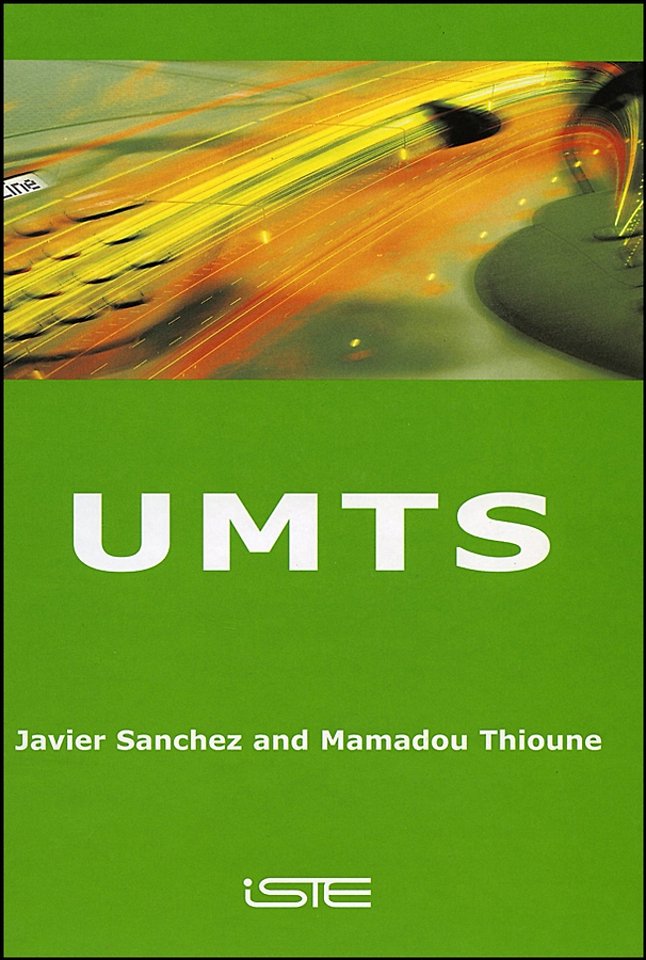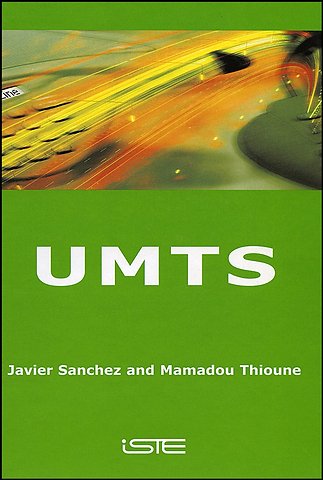Umts
Samenvatting
During the first decade of this new millennium, it is estimated that more than 100 billion will be invested in the third generation (3G) Universal Mobile Telecommunications System (UMTS) in Europe. This fact represents an amazing challenge from both a technical and commercial perspective. Written by experts in the field, this book gives a detailed description of the elements in the UMTS network architecture: the User Equipment (UE), the UMTS Radio Access Network (UTRAN) and the core network. The completely new protocols based on the needs of the new Wideband Code Division Multiple Access (WCDMA) air interface are highlighted by considering both Frequency– and Time–Division Duplex modes. The book further introduces the key features of existing topics in Releases 5, 6 and 7.
Specificaties
Inhoudsopgave
<p>Chapter 1. Evolution of Cellular Mobile Systems 1</p>
<p>1.1. Multiple–access techniques used in mobile telephony 2</p>
<p>1.1.1. Frequency division duplex (FDD) and time division duplex (TDD) 2</p>
<p>1.1.2. Frequency division multiple access (FDMA) 3</p>
<p>1.1.3. Time division multiple access (TDMA) 3</p>
<p>1.1.4. Code division multiple access (CDMA) 3</p>
<p>1.1.5. Space division multiple access (SDMA) 5</p>
<p>1.1.6. Orthogonal frequency division multiplexing (OFDM) 6</p>
<p>1.2. Evolution from 1G to 2.5G 8</p>
<p>1.2.1. From 1G to 2G 8</p>
<p>1.2.2. Enhancements to 2G radio technologies: 2.5G 8</p>
<p>1.3. 3G systems in IMT–2000 framework 11</p>
<p>1.3.1. IMT–2000 radio interfaces 12</p>
<p>1.3.2. Core network approaches in 3G systems 18</p>
<p>1.4. Standardization process in 3G systems 19</p>
<p>1.5. Worldwide spectrum allocation for IMT–2000 systems 20</p>
<p>1.5.1. WARC–92 20</p>
<p>1.5.2. WARC–2000 22</p>
<p>Chapter 2. Network Evolution from GSM to UMTS 25</p>
<p>2.1. Introduction 25</p>
<p>2.2. UMTS definition and history 25</p>
<p>2.3. Overall description of a UMTS network architecture 27</p>
<p>2.4. Network architecture evolution from GSM to UMTS 28</p>
<p>2.4.1. GSM network architecture of Phases 1 and 2 28</p>
<p>2.4.2. GSM network architecture of Phase 2+ 29</p>
<p>2.4.3. Architecture of UMTS networks: evolutionary revolution of GSM 31</p>
<p>2.5. Bearer services offered by UMTS networks 32</p>
<p>2.6. UMTS protocol architecture based on stratum concept 33</p>
<p>2.6.1. Access stratum 34</p>
<p>2.6.2. Non–access stratum 35</p>
<p>Chapter 3. Services in UMTS 37</p>
<p>3.1. Introduction 37</p>
<p>3.2. UMTS mobile terminals 38</p>
<p>3.2.1. UE functional description 38</p>
<p>3.2.2. UE maximum output power 41</p>
<p>3.2.3. Dual–mode GSM/UMTS terminals 42</p>
<p>3.2.4. UE radio access capability 43</p>
<p>3.3. Services offered by UMTS networks 44</p>
<p>3.3.1. Standard UMTS telecommunication services 44</p>
<p>3.3.2. UMTS bearer services 45</p>
<p>3.3.3. Teleservices 49</p>
<p>3.3.4. Supplementary services 52</p>
<p>3.3.5. Operator specific services: service capabilities 54</p>
<p>3.3.6. The virtual home environment 55</p>
<p>3.4. Traffic classes of UMTS bearer services 56</p>
<p>3.4.1. Conversational services 57</p>
<p>3.4.2. Streaming services 57</p>
<p>3.4.3. Interactive services 57</p>
<p>3.4.4. Background services 58</p>
<p>3.5. Service continuity across GSM and UMTS networks 58</p>
<p>Chapter 4. UMTS Core Network 61</p>
<p>4.1. Introduction 61</p>
<p>4.2. UMTS core network architecture 61</p>
<p>4.2.1. Main features of UMTS core network based on Release 99 62</p>
<p>4.2.2. Circuit–switched and packet–switched domains 63</p>
<p>4.3. Network elements and protocols of the CS and PS domains 65</p>
<p>4.3.1. Network elements of the CS domain 65</p>
<p>4.3.2. Protocol architecture in the CS domain 66</p>
<p>4.3.3. Network elements of the PS domain 71</p>
<p>4.3.4. Protocol architecture in the PS domain 72</p>
<p>4.3.5. Integrated UMTS core network 80</p>
<p>4.4. Network elements not included in UMTS reference architecture 81</p>
<p>4.5. Interoperability between UMTS and GSM core networks 82</p>
<p>Chapter 5. Spread Spectrum and WCDMA 85</p>
<p>5.1. Introduction 85</p>
<p>5.2. Spread spectrum principles 85</p>
<p>5.2.1. Processing gain 87</p>
<p>5.2.2. Advantages of spread spectrum 87</p>
<p>5.3. Direct sequence CDMA 88</p>
<p>5.4. Multiple access based on spread spectrum 90</p>
<p>5.5. Maximum capacity of CDMA 91</p>
<p>5.5.1. Effect of background noise and interference 92</p>
<p>5.5.2. Antenna sectorization 93</p>
<p>5.5.3. Voice activity detection 93</p>
<p>5.6. Spreading code sequences 94</p>
<p>5.6.1. Orthogonal code sequences 95</p>
<p>5.6.2. Pseudo–noise code sequences: Gold codes 96</p>
<p>5.6.3. Spreading sequences used in UTRA 98</p>
<p>5.7. Principles of wideband code division multiple access 99</p>
<p>5.7.1. Effects of the propagation channel 100</p>
<p>5.7.2. Techniques used in WCDMA for propagation impairment mitigation 102</p>
<p>Chapter 6. UTRAN Access Network 113</p>
<p>6.1. Introduction 113</p>
<p>6.2. UTRAN architecture 113</p>
<p>6.2.1. The radio network sub–system (RNS) 115</p>
<p>6.2.2. Handling of the mobility in the UTRAN 119</p>
<p>6.2.3. Summary of functions provided by the UTRAN 120</p>
<p>6.3. General model of protocols used in UTRAN interfaces 121</p>
<p>6.3.1. Horizontal layers 122</p>
<p>6.3.2. Vertical planes 122</p>
<p>6.3.3. Control plane of the transport network 124</p>
<p>6.4. Use of ATM in the UTRAN network transport layer 125</p>
<p>6.4.1. ATM cell format 125</p>
<p>6.4.2. ATM and virtual connections 126</p>
<p>6.4.3. ATM reference model 127</p>
<p>6.5. Protocols in the Iu interface 128</p>
<p>6.5.1. Protocol architecture in Iu–CS and Iu–PS interfaces 128</p>
<p>6.5.2. RANAP 132</p>
<p>6.6. Protocols in internal UTRAN interfaces 134</p>
<p>6.6.1. Iur interface (RNC–RNC) 134</p>
<p>6.6.2. Iub interface (RNC–Node B) 137</p>
<p>6.7. Data exchange in the UTRAN: example of call establishment 139</p>
<p>6.8. Summary of the UTRAN protocol stack 141</p>
<p>Chapter 7. UTRA Radio Protocols 145</p>
<p>7.1. Introduction 145</p>
<p>7.2. Channel typology and description 146</p>
<p>7.2.1. Logical channels 147</p>
<p>7.2.2. Transport channels 147</p>
<p>7.2.3. Physical channels 151</p>
<p>7.3. Physical layer 152</p>
<p>7.3.1. Physical layer functions 153</p>
<p>7.3.2. Mapping of transport channels onto physical channels 154</p>
<p>7.4. MAC 156</p>
<p>7.4.1. Main functions of MAC 157</p>
<p>7.4.2. Mapping of logical channels onto transport channels 157</p>
<p>7.4.3. MAC PDU 158</p>
<p>7.5. RLC 160</p>
<p>7.5.1. Main functions of RLC 161</p>
<p>7.5.2. RLC PDU 162</p>
<p>7.5.3. RLC transmission and reception model 165</p>
<p>7.6. PDCP 166</p>
<p>7.7. BMC 169</p>
<p>7.8. RRC 170</p>
<p>7.8.1. Handling of the RRC connection 170</p>
<p>7.8.2. Handling of RRC service states 171</p>
<p>7.8.3. System information broadcast 173</p>
<p>7.8.4. Handling of the paging 175</p>
<p>7.8.5. Cell selection and reselection 176</p>
<p>7.8.6. UTRAN mobility handling 176</p>
<p>7.8.7. Radio bearer management 179</p>
<p>7.8.8. Measurement control 182</p>
<p>7.8.9. Ciphering and integrity 183</p>
<p>7.8.10. Outer loop power control 185</p>
<p>7.8.11. Protocol layers termination in the UTRAN 185</p>
<p>Chapter 8. Call and Mobility Management 187</p>
<p>8.1. Introduction 187</p>
<p>8.2. PLMN selection 188</p>
<p>8.2.1. Automatic PLMN selection mode 190</p>
<p>8.2.2. Manual PLMN selection mode 190</p>
<p>8.2.3. PLMN reselection 191</p>
<p>8.2.4. Forbidden PLMNs 191</p>
<p>8.3. Principle of mobility management in UMTS 192</p>
<p>8.3.1. Location areas 193</p>
<p>8.3.2. Service states in the core network and the UTRAN 195</p>
<p>8.4. Network access control 195</p>
<p>8.4.1. Allocation of temporary identities 195</p>
<p>8.4.2. UE identification procedure 196</p>
<p>8.4.3. Ciphering and integrity protection activation 197</p>
<p>8.4.4. Authentication 198</p>
<p>8.5. Network registration 201</p>
<p>8.5.1. IMSI attach procedure 201</p>
<p>8.5.2. GPRS attach procedure 202</p>
<p>8.6. UE location updating procedures 205</p>
<p>8.6.1. Location updating procedure 205</p>
<p>8.6.2. Routing area updating procedure 207</p>
<p>8.6.3. SRNS relocation 209</p>
<p>8.6.4. Detach procedures 215</p>
<p>8.7. Call establishment 215</p>
<p>8.7.1. Circuit call 215</p>
<p>8.7.2. Packet call 217</p>
<p>8.8. Intersystem change and handover between GSM and UMTS networks 220</p>
<p>8.8.1. Intersystem handover from UMTS to GSM during a CS connection 220</p>
<p>8.8.2. Intersystem handover from GSM to UMTS during a CS connection 222</p>
<p>8.8.3. Intersystem change from UMTS to GPRS during a PS session 223</p>
<p>8.8.4. Intersystem change from GPRS to UMTS during a PS session 223</p>
<p>Chapter 9. UTRA/FDD Transmission Chain 227</p>
<p>9.1. Introduction 227</p>
<p>9.2. Operations applied to transport channels 228</p>
<p>9.2.1. Multiplexing and channel coding in the uplink 228</p>
<p>9.2.2. Multiplexing and channel coding in the downlink 236</p>
<p>9.3. Operations applied to physical channels 238</p>
<p>9.3.1. Characteristics of physical channels in UTRA/FDD 238</p>
<p>9.3.2. Channelization codes 239</p>
<p>9.3.3. Scrambling codes 241</p>
<p>9.3.4. UTRA/WCDMA transmitter 244</p>
<p>9.4. Spreading and modulation of dedicated physical channels 248</p>
<p>9.4.1. Uplink dedicated channels 248</p>
<p>9.4.2. Downlink dedicated channel 255</p>
<p>9.4.3. Time difference between uplink and downlink DPCHs 260</p>
<p>9.5. Spreading and modulation of common physical channels 261</p>
<p>9.5.1. The Physical Random Access Channel (PRACH) 261</p>
<p>9.5.2. The Physical Common Packet Channel (PCPCH) 262</p>
<p>9.5.3. The Physical Downlink Shared Channel (PDSCH) 263</p>
<p>9.5.4. The Synchronization Channel (SCH) 264</p>
<p>9.5.5. The Common Pilot Channel (CPICH) 265</p>
<p>9.5.6. The Primary Common Control Physical Channel (P–CCPCH) 266</p>
<p>9.5.7. The Secondary Common Control Physical Channel (S–CCPCH) 267</p>
<p>9.5.8. The Paging Indicator Channel (PICH) 268</p>
<p>9.5.9. The Acquisition Indicator Channel (AICH) 268</p>
<p>9.5.10. Other downlink physical channels associated with the PCPCH 269</p>
<p>Chapter 10. UTRA/FDD Physical Layer Procedures 271</p>
<p>10.1. Introduction 271</p>
<p>10.2. The UE receptor 271</p>
<p>10.3. Synchronization procedure 273</p>
<p>10.3.1. First step: slot synchronization 274</p>
<p>10.3.2. Second step: frame synchronization and code–group identification 275</p>
<p>10.3.3. Third step: primary scrambling code identification 276</p>
<p>10.3.4. Fourth step: system frame synchronization 276</p>
<p>10.4. Random access transmission with the RACH 277</p>
<p>10.5. Random access transmission with the CPCH 279</p>
<p>10.6. Paging decoding procedure 280</p>
<p>10.7. Power control procedures 282</p>
<p>10.7.1. Open loop power control 282</p>
<p>10.7.2. Inner loop and outer loop power control 283</p>
<p>10.8. Transmit diversity procedures 286</p>
<p>10.8.1. Time Switched Transmit Diversity (TSTD) 287</p>
<p>10.8.2. Space Time block coding Transmit Diversity (STTD) 288</p>
<p>10.8.3. Closed loop transmit diversity 289</p>
<p>Chapter 11. Measurements and Procedures of the UE in RRC Modes 291</p>
<p>11.1. Introduction 291</p>
<p>11.2. Measurements performed by the physical layer 291</p>
<p>11.2.1. Measurement model for physical layer 292</p>
<p>11.2.2. Types of UE measurements 293</p>
<p>11.3. Cell selection process 294</p>
<p>11.3.1. PLMN search and selection 295</p>
<p>11.3.2. Phases in the cell selection process 296</p>
<p>11.3.3. S cell selection criterion 298</p>
<p>11.4. Cell reselection process 299</p>
<p>11.4.1. Types of cell reselection 300</p>
<p>11.4.2. Measurement rules for cell reselection 301</p>
<p>11.4.3. R ranking criterion 301</p>
<p>11.4.4. Phases in the cell reselection process 302</p>
<p>11.5. Handover procedures 303</p>
<p>11.5.1. Phases in a handover procedure 304</p>
<p>11.5.2. Intrafrequency handover 305</p>
<p>11.5.3. Interfrequency handover 310</p>
<p>11.5.4. Intersystem UMTS–GSM handover 312</p>
<p>11.6. Measurements in idle and connected RRC modes 312</p>
<p>11.6.1. Measurements in RRC idle, CELL—PCH and URA—PCH states 312</p>
<p>11.6.2. Measurements in CELL—FACH state 313</p>
<p>11.6.3. Measurements in the CELL—DCH state: the compressed mode 315</p>
<p>Chapter 12. UTRA/TDD Mode 321</p>
<p>12.1. Introduction 321</p>
<p>12.2. Technical aspects of UTRA/TDD 321</p>
<p>12.2.1. Advantages of UTRA/TDD 322</p>
<p>12.2.2. Drawbacks of UTRA/TDD 324</p>
<p>12.3. Transport and physical channels in UTRA/TDD 325</p>
<p>12.3.1. Physical channel structure 326</p>
<p>12.3.2. Dedicated Physical Data Channels 328</p>
<p>12.3.3. Common physical channels 329</p>
<p>12.4. Service multiplexing and channel coding 334</p>
<p>12.4.1. Examples of UTRA/TDD user bit rates 335</p>
<p>12.5. Physical layer procedures in UTRA/TDD 336</p>
<p>12.5.1. Power control 336</p>
<p>12.5.2. Downlink transmit diversity 338</p>
<p>12.5.3. Timing advance 339</p>
<p>12.5.4. Dynamic channel allocation 339</p>
<p>12.5.5. Handover 340</p>
<p>12.6. UTRA/TDD receiver 340</p>
<p>Chapter 13. UMTS Network Evolution 343</p>
<p>13.1. Introduction 343</p>
<p>13.2. UMTS core network based on Release 4 345</p>
<p>13.3. UMTS core network based on Release 5 347</p>
<p>13.4. Multimedia Broadcast/Multicast Service (MBMS) 349</p>
<p>13.4.1. Network aspects 349</p>
<p>13.4.2. MBMS operation modes 350</p>
<p>13.4.3. MBMS future evolution 351</p>
<p>13.5. UMTS–WLAN interworking 352</p>
<p>13.5.1. UMTS–WLAN interworking scenarios 352</p>
<p>13.5.2. Network and UE aspects 354</p>
<p>13.6. UMTS evolution beyond Release 7 355</p>
<p>13.6.1. HSDPA/HSUPA enhancements 356</p>
<p>13.6.2. System Architecture Evolution 356</p>
<p>13.6.3. Long Term Evolution (LTE) 357</p>
<p>Chapter 14. Principles of HSDPA 359</p>
<p>14.1. HSDPA physical layer 359</p>
<p>14.1.1. HS–DSCH transport channel 361</p>
<p>14.1.2. Mapping of HS–DSCH onto HS–PDSCH physical channels 362</p>
<p>14.1.3. Physical channels associated with the HS–DSCH 363</p>
<p>14.1.4. Timing relationship between the HS–PDSCH and associated channels 366</p>
<p>14.2. Adaptive modulation and coding 366</p>
<p>14.3. Hybrid Automatic Repeat Request (H–ARQ) 367</p>
<p>14.4. H–ARQ process example 369</p>
<p>14.5. Fast scheduling 370</p>
<p>14.6. New architecture requirements for supporting HSDPA 371</p>
<p>14.6.1. Impact on Node B: high–speed MAC entity 371</p>
<p>14.6.2. Impact on the UE: HSDPA terminal capabilities 372</p>
<p>14.7. Future enhancements for HSDPA 373</p>
<p>14.7.1. Enhanced UTRA/FDD uplink 373</p>
<p>14.7.2. Multiple Input Multiple Output antenna processing 374</p>
<p>Appendix 1. AMR Codec in UMTS 375</p>
<p>A1.1. AMR frame structure and operating modes 376</p>
<p>A1.2. Dynamic AMR mode adaptation 378</p>
<p>A1.3. Resource allocation for an AMR speech connection 380</p>
<p>A1.4. AMR wideband 380</p>
<p>Appendix 2. Questions and Answers 383</p>
<p>Bibliography 395</p>
<p>Glossary 399</p>
<p>Index 417</p>

